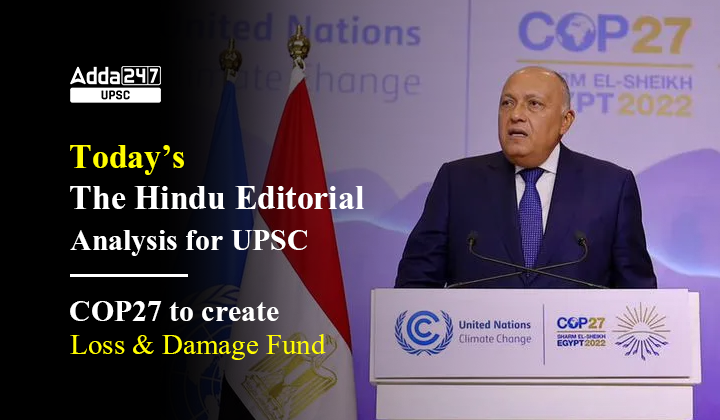Table of Contents
COP27 to Create a Special Loss and Damage Fund – Importance for UPSC
For UPSC examination purpose, COP 27 and related happenings are must read for every serious aspirant.
Creating a special fund for loss and damage marked an important point of progress at COPs, so it is important for both UPSC Pre and Mains examination 2023-24.
It is also an important part of GS 2: Important International Institutions and GS 3: Environmental Conservation.
Why Loss and Damage Fund in news?
- The 27th UN Conference of Parties (COP27) of the UNFCCC closed with a breakthrough agreement to provide “loss and damage” funding for vulnerable countries hit hard by climate disasters.
- Nearly 200 countries struck a historic deal to establish a new fund for climate “loss and damage” – it will give money to the nations hit hardest by the effects of climate change.
- Creating a specific fund for loss and damage marked an important point of progress, with the issue added to the official agenda and adopted for the first time at COP27.
What is special Loss and Damage Fund agreed upon by COP 27?
- Loss and damage funding which is agreed upon by COP 27 refers to financial compensation that directly addresses unavoidable climate change catastrophes that developing countries are particularly vulnerable to.
- The Loss and Damage Fund will help to make up for the losses suffered by developing nations that are vulnerable to climate change.
- Parties also agreed on the institutional arrangements to operationalize the Santiago Network for Loss and Damage, to catalyze technical assistance to developing countries that are particularly vulnerable to the adverse effects of climate change.
What is Santiago Network for Loss and Damage?
-
- The vision of the Santiago Network is to catalyze the technical assistance of relevant organizations, bodies, networks and experts, for the implementation of relevant approaches for averting, minimize and addressing L&D at the local, national and regional level, in developing countries that are particularly vulnerable to the adverse effects of climate change.
- At COP 25 in Madrid, Spain Parties established the Santiago network as part of the WIM.
- At COP 26 in Glasgow, UK Parties decided on the functions of the Santiago Network and issued a call for submissions.
How historic is the decision to create the Loss and Damage Fund?
- With the announcement of the creation of a special Loss and Damage Fund at COP27, a nearly three-decade-old movement, first initiated by the island nation of Vanuatu and the Alliance of Small Island States, has come to partial fruition.
- There will now be a dedicated fund to compensate the most vulnerable developing countries that are already bearing the brunt of climate change-linked natural disasters.
- L&D refers to impacts of climate change that cannot be avoided either by mitigation (cutting greenhouse gas emissions) or adaptation (modifying practices to buffer against climate change impacts). They also include not only economic damage to property but also loss of livelihoods, and the destruction of biodiversity and sites that have cultural importance. This broadens the scope for affected nations to claim compensation.
What could not be achieved at COP 27?
- There was disappointment among some that no new commitments on phasing out fossil fuels and cutting greenhouse gas emissions were included in the summit’s overarching agreement
- The existing pledge to try to limit global warming to the key threshold of 1.5C above pre-industrial levels was retained – but there is concern it is slipping out of reach, with UN chief António Guterres saying a “giant leap” on climate ambition is still needed and the planet is still “in the emergency room”.
Limitations of Loss and Damage Fund
- The text approved at Sharm el-Sheikh only commits to a fund being created and leaves discussions for how it is to be set up and, most importantly, who will pay how much to it, for future COP negotiations.
- While there have been nominal commitments by Scotland and Wallonia (Belgium) to donate to such a fund, the estimated L&D is already over $500 billion.
- During negotiations this year, the European Union pressed hard for China, the Arab states and “large, developing countries” — and this could include India — to contribute on the grounds that they were large emitters.
- This already opens up fresh occasion for acrimony in future COPs and given that barely a third of committed climate finance has made its way to developing countries, the L&D fund too might take years before it can meaningfully operate.
Conclusion
While the decision at COP27 to Create a Special Loss and Damage Fund is historic and the gain is incremental, countries ought not to lose momentum and must work harder to ensure that COPs remain credible catalysts and are not occasions for pyrrhic victories.
FAQs
Q. What is Loss and Damage Fund which is agreed upon by COP 27?
Ans. Loss and damage funding which is agreed upon by COP 27 refers to financial compensation that directly addresses unavoidable climate change catastrophes that developing countries are particularly vulnerable to.
Q. What is 1.5°C target?
Ans: The 1.5 °C target is the target of Paris Agreement 2015 to close the emissions gap and prevent rise in average global temperature beyond 1.5°C.
Q. When Paris Agreement on Climate Change was ratified?
Ans: Paris Agreement on Climate Change was ratified in the year 2015.
Q. What is COP 27?
Ans: COP27 is the 27th annual UN meeting on climate.
Q. Where did COP 27 held and why?
Ans: COP 27 held at Sharm elSheikh, Egypt to review progress, raise ambition on emissions cuts and draw up funding plans to help vulnerable countries adapt to climate change.
What is the Focus of COP 27?



 TSPSC Group 1 Question Paper 2024, Downl...
TSPSC Group 1 Question Paper 2024, Downl...
 TSPSC Group 1 Answer key 2024 Out, Downl...
TSPSC Group 1 Answer key 2024 Out, Downl...
 UPSC Prelims 2024 Question Paper, Downlo...
UPSC Prelims 2024 Question Paper, Downlo...





